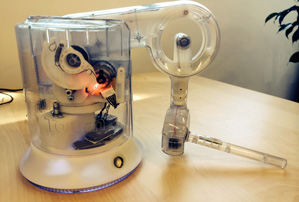A Cheaper Tool for Virtual Sculpting
In medical examiners’ offices around the United States alone, some 25,000 unidentified human skulls, many of homicide victims, await identification. That process can be greatly aided by generating a 3-D reconstruction of what the person’s face may have looked like.

Now the price of one key technology that allows this, and has many other applications besides, is dropping fast. The technology is called a haptic stylus—a gadget connected to mechanical apparatus that gives force-feedback sensations to let artists “feel” what they’re doing as they sculpt a 3-D image on the screen, such as from a CT scan of a skull.
The new haptic stylus, due out next month from 3D Systems in Rock Hill, South Carolina, will cost just $649, down from a range of $2,400 to $13,000 for existing devices.
Haptic styluses and similar hardware have been used for years for niche applications and for high-end 3-D design and medical training—for example, to allow students to practice a complex procedure using a simulation system that feels as realistic as it looks. More broadly, “haptics”—technologies that add physical sensation—is a common feature in products like computer mouses that vibrate and game joysticks that shake, and even touch screens that vibrate, making you feel like there’s a sharp edge on a flat surface.
The new product from 3D Systems is part of a trend toward far cheaper tools to allow for 3-D imaging, modeling, and printing for a variety of applications (see “What Yoda Taught Me About 3-D Printing” and “The Difference Between Makers and Manufacturers”). 3D Systems, for example, makes many 3-D printers and recently launched a sub-$1,000 home model called Cube and a $400 handheld scanner that can, in a couple of minutes, generate a realistic 3-D drawing of a human head that’s as good as the ones produced by existing stationary systems costing thousands of dollars.
The cheaper haptic stylus is a descendant of a product called Phantom originally invented by an MIT startup called Sensable, whose technology was acquired by 3D Systems. “There has always been an exclusive and high cost barrier to doing this,” says Ping Fu, chief entrepreneur officer at 3D Systems. “This brings that kind of ability right down into the consumer space, so anybody can pick up the haptic device and start sculpting.”
Joe Mullins, a forensic artist who builds 3-D facial reconstructions for the National Center for Missing and Exploited Children, says cheaper versions of the technology will be crucial to making it practical for far more artists to get involved in such work, as well as related work in archaeology, in addition to other types of 3-D renderings. “For an artist, you can’t beat that haptic device, or touch and feel. That is what we live for,” he says. “You can tell what you are doing. You have more finesse when it comes to adding style and details of an eyelash, or a facial feature that you really can’t get just using a regular mouse.”
As a practical matter, it will also offer museum restoration artists and others a way to put faces to long-dead victims. “For museums, there is no other way to do it—you aren’t going to ship a 2,000 year old Egyptian mummy in the mail,” he says. “You do a CT scan and send the disk back.”
Keep Reading
Most Popular
Large language models can do jaw-dropping things. But nobody knows exactly why.
And that's a problem. Figuring it out is one of the biggest scientific puzzles of our time and a crucial step towards controlling more powerful future models.
How scientists traced a mysterious covid case back to six toilets
When wastewater surveillance turns into a hunt for a single infected individual, the ethics get tricky.
The problem with plug-in hybrids? Their drivers.
Plug-in hybrids are often sold as a transition to EVs, but new data from Europe shows we’re still underestimating the emissions they produce.
Google DeepMind’s new generative model makes Super Mario–like games from scratch
Genie learns how to control games by watching hours and hours of video. It could help train next-gen robots too.
Stay connected
Get the latest updates from
MIT Technology Review
Discover special offers, top stories, upcoming events, and more.